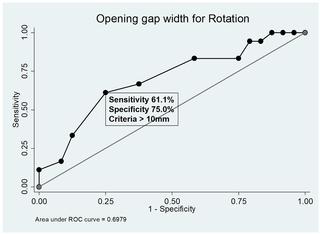Our official English website, www.x-mol.net, welcomes your feedback! (Note: you will need to create a separate account there.)
Opening gap width influences distal tibial rotation below the osteotomy site following open wedge high tibial osteotomy.
PLOS ONE ( IF 3.7 ) Pub Date : 2020-01-16 , DOI: 10.1371/journal.pone.0227969 Jun-Ho Kim 1 , Hoon-Young Kim 1 , Dae-Hee Lee 1
PLOS ONE ( IF 3.7 ) Pub Date : 2020-01-16 , DOI: 10.1371/journal.pone.0227969 Jun-Ho Kim 1 , Hoon-Young Kim 1 , Dae-Hee Lee 1
Affiliation

|
PURPOSE
Although rotation of the distal portion of the tibia below the osteotomy site is considered an inevitable change in the axial plane in open wedge high tibial osteotomy (HTO), several studies on this issue have shown contradictory results. The purpose of this study was, therefore, to determine the direction and amount of distal tibial rotation following open wedge HTO using a three-dimensional reconstructed model.
METHODS
This study involved 41 patients (42 knees) undergoing open wedge HTO for primary medial osteoarthritis. Distal tibial rotation was measured on the overlaid tibial plateau of a preoperative and postoperative 3-dimensional reconstructed model based on computed tomography.
RESULTS
The mean distal tibial external rotation was 2.7° ± 2.3° (range, -0.9° to 9.9°), and the opening gap was larger in the group with > 3° distal tibial rotation than in the group with ≤ 3° distal tibial rotation (11.4 mm vs. 9.6 mm, P = 0.027). Multiple regression analysis showed that the opening gap was the only predictor of distal tibial rotation. On receiver operating characteristics analysis, an opening gap of 10 mm was found to be the optimal cutoff value for achieving greater than 3° of distal tibial rotation.
CONCLUSIONS
Following medial opening wedge HTO, the distal tibial portion below the osteotomy site rotated approximately 3° externally. The magnitude of the external rotation of the distal tibia was affected by the opening gap width.
中文翻译:

开口间隙宽度影响开放楔形高位胫骨截骨术后截骨部位下方的远端胫骨旋转。
目的尽管在开放性楔形高位胫骨截骨术(HTO)中,胫骨远端部分在截骨术部位以下的旋转被认为是轴向平面的必然变化,但对此问题的多项研究显示出矛盾的结果。因此,本研究的目的是使用三维重建模型确定开放楔形HTO后胫骨远端旋转的方向和量。方法该研究涉及41例(42膝)因原发性内侧骨关节炎行楔形开放性HTO手术的患者。在基于计算机断层扫描的术前和术后3维重建模型的覆盖胫骨平台上测量胫骨远端旋转。结果胫骨远端平均外旋角为2.7°±2.3°(范围-0.9°至9.9°),并且> 胫骨远端旋转3°小于胫骨远端旋转≤3°的组(11.4 mm和9.6 mm,P = 0.027)。多元回归分析表明,开放间隙是胫骨远端旋转的唯一预测因子。在接受者操作特征分析中,发现10 mm的开口间隙是实现大于3°的胫骨远端旋转的最佳截止值。结论内侧开口楔形HTO后,截骨部位下方的胫骨远端部分向外旋转约3°。胫骨远端外旋的大小受开口间隙宽度的影响。在接受者操作特征分析中,发现10 mm的开口间隙是实现大于3°的胫骨远端旋转的最佳截止值。结论内侧开口楔形HTO后,截骨部位下方的胫骨远端部分向外旋转约3°。胫骨远端外旋的大小受开口间隙宽度的影响。在接受者操作特征分析中,发现10 mm的开口间隙是实现大于3°的胫骨远端旋转的最佳截止值。结论内侧开口楔形HTO后,截骨部位下方的胫骨远端部分向外旋转约3°。胫骨远端外旋的大小受开口间隙宽度的影响。
更新日期:2020-01-17
中文翻译:

开口间隙宽度影响开放楔形高位胫骨截骨术后截骨部位下方的远端胫骨旋转。
目的尽管在开放性楔形高位胫骨截骨术(HTO)中,胫骨远端部分在截骨术部位以下的旋转被认为是轴向平面的必然变化,但对此问题的多项研究显示出矛盾的结果。因此,本研究的目的是使用三维重建模型确定开放楔形HTO后胫骨远端旋转的方向和量。方法该研究涉及41例(42膝)因原发性内侧骨关节炎行楔形开放性HTO手术的患者。在基于计算机断层扫描的术前和术后3维重建模型的覆盖胫骨平台上测量胫骨远端旋转。结果胫骨远端平均外旋角为2.7°±2.3°(范围-0.9°至9.9°),并且> 胫骨远端旋转3°小于胫骨远端旋转≤3°的组(11.4 mm和9.6 mm,P = 0.027)。多元回归分析表明,开放间隙是胫骨远端旋转的唯一预测因子。在接受者操作特征分析中,发现10 mm的开口间隙是实现大于3°的胫骨远端旋转的最佳截止值。结论内侧开口楔形HTO后,截骨部位下方的胫骨远端部分向外旋转约3°。胫骨远端外旋的大小受开口间隙宽度的影响。在接受者操作特征分析中,发现10 mm的开口间隙是实现大于3°的胫骨远端旋转的最佳截止值。结论内侧开口楔形HTO后,截骨部位下方的胫骨远端部分向外旋转约3°。胫骨远端外旋的大小受开口间隙宽度的影响。在接受者操作特征分析中,发现10 mm的开口间隙是实现大于3°的胫骨远端旋转的最佳截止值。结论内侧开口楔形HTO后,截骨部位下方的胫骨远端部分向外旋转约3°。胫骨远端外旋的大小受开口间隙宽度的影响。


























 京公网安备 11010802027423号
京公网安备 11010802027423号